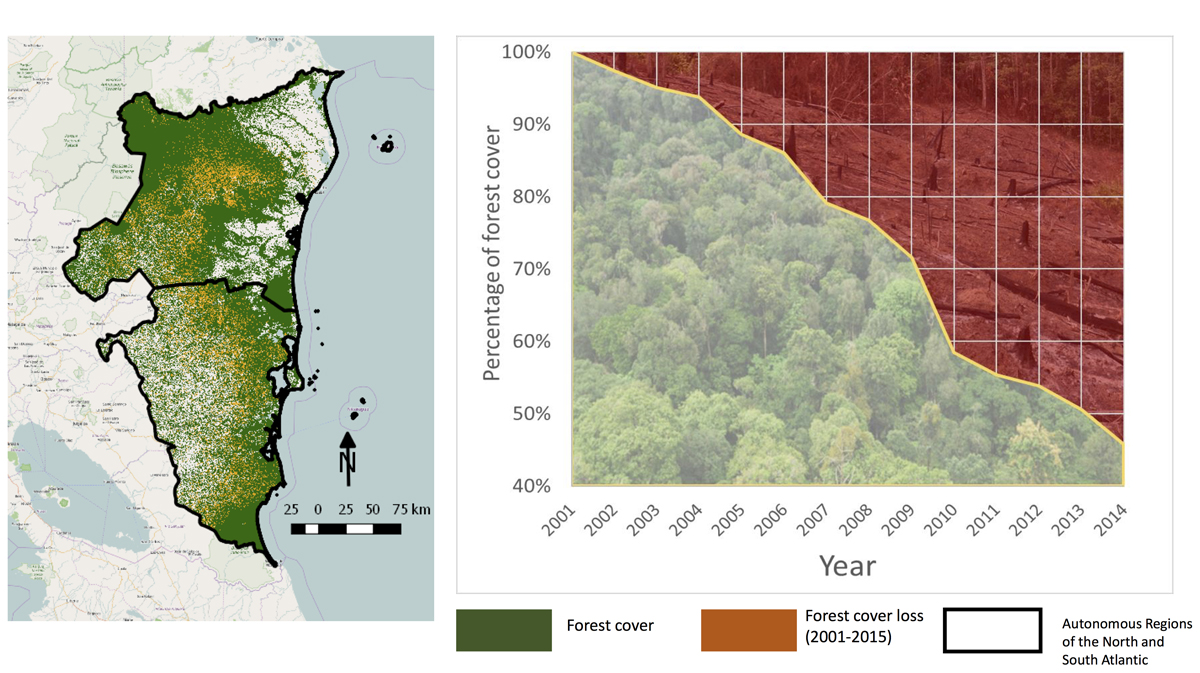- Patterns of deforestation show a steady march of the agricultural frontier as non-indigenous colonists claim land for cultivation.
- The Atlantic Autonomous Regions of the North and South (RAAN and RAAS) have lost up to 40 percent of their nucleus, while further south, protected areas such as Punta Gorda and Cerro Silva Nature Reserves have lost 25 percent of their forest cover.
- Undoubtedly, enforcement of environmental and indigenous law is hampered by limited financial resources in Nicaragua, one of the poorest countries in the Western Hemisphere. However, some Nicaraguan scientists have suggested that an aggressively extractivist orientation is the prevailing political current.
Nicaragua is home to what is perhaps the last wild frontier of Central America. The nation boasts over one-quarter of the region’s remaining forest cover, about 20 percent of which is old growth situated squarely in the Mesoamerican Biological Corridor.
Recent media coverage has highlighted the potential environmental damage that a proposed inter-oceanic canal portends. Evidence, however, is mounting that this improbable project will not go forward. Nevertheless, Nicaragua’s wild areas are under siege by other — very insidious — forces that threaten the future of regional biodiversity.
Patterns of deforestation show a steady march of the agricultural frontier as non-indigenous colonists claim land for cultivation. The Atlantic Autonomous Regions of the North and South (RAAN and RAAS) have lost up to 40 percent of their nucleus (see maps here), while further south, protected areas such as Punta Gorda and Cerro Silva Nature Reserves have lost 25 percent of their forest cover. All of this is occurring under the apparently blind-eye gaze of the ministry of the environment (MARENA) and the army, the two governmental entities with jurisdiction to enforce relevant laws.


The Indio Maíz Biological Reserve shows incipient trends that mirror these other areas. To date, it has lost over 2,000 hectares (close to 5,000 acres) of forest over the past 15 years, including about 1,000 hectares within a mere eight kilometers of the Indio Maíz military post. Meanwhile, citizens’ pleas for intervention have gone unheeded or, worse, their efforts thwarted by threats (see also: Indio Maíz invaded).
Undoubtedly, enforcement of environmental and indigenous law is hampered by limited financial resources in Nicaragua, one of the poorest countries in the Western Hemisphere. However, some Nicaraguan scientists have suggested that an aggressively extractivist orientation is the prevailing political current. If so, it may be costly and inconvenient to protect biological diversity when the land that harbors it might instead be exploited.

In fact, the Nicaraguan government seems to be committed to promoting extractivist economic activities. Whether justified or not, there is an air of lawlessness and free-wheeling-and-dealing that first arose with news of the canal proposal. It is exacerbated by recent Nicaraguan and Russian news sources asserting that the current administration is encouraging the sale of 4.9 million hectares (12.1 million acres) to foreign investors. This is promoting fear and speculation that protected areas are up for sale. (Read more here and here.)
If protected areas are sold, this could imperil a chain of reserves and indigenous territories that, until recently, comprised a largely uninterrupted swath of closed-canopy lowland rainforest that effectively connected Costa Rica to Honduras. Still harboring great biological diversity and source populations of keystone species, the Atlantic slope of Nicaragua impacts the ecological health and well-being of ecosystems well beyond the nation’s borders.
Like a keystone species, this swath of the Mesoamerican Biological Corridor plays a key role. Its position, expanse, and overall integrity bring great resilience and diversity to the ecological communities of Central America. The plight of Nicaragua’s Atlantic slopes should therefore be of great interest to conservationists worldwide.

Nevertheless, leveraging international concern to thwart the current trends in Nicaragua may be an uphill battle. The current administration tends toward isolationism when convenient. For example, Nicaragua is one of very few nations at the COP21 Paris meetings to refuse to craft a national plan to reduce greenhouse gas emissions. Claiming no responsibility for global warming, Nicaragua chose to go against a strong international tide of near-consensus for action.
Other acts by the current administration likewise suggest that they are not keen on exposure to outside influences. For instance, about a dozen foreign professionals (including academics, NGO workers, journalists, and U.S. government officials) have been denied entry, detained, deported, or questioned in the last several months, prompting the US Department of State to issue a travel alert to US citizens residing in or traveling to Nicaragua. (See US State Dept. travel alert here.)

Will Nicaragua’s government likewise isolate itself against an emerging domestic consensus being voiced by Nicaraguan scientists, scholars, indigenous people, and other nationals? Although disparate, their messages converge on similar concerns and calls for environmental protection and indigenous sovereignty (read more here and here). Hopefully, in this election year for Nicaragua, the current administration will see its constituents’ calls for action as an opportunity to commit to national environmental stewardship.
Should the government instead choose the path of inaction as it did in Paris, responsibility for an epic loss of Nicaraguan biodiversity will not be so easily deflected to other nations.
